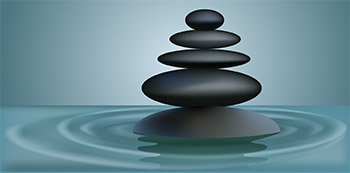 Have you ever been frustrated by not being able to do everything you set out to do in a given day? Einstein might have the answer to your problems.
Have you ever been frustrated by not being able to do everything you set out to do in a given day? Einstein might have the answer to your problems.
As I’ve mentioned here before, in my coaching practice I predominantly help clients to understand and fix self-sabotage: the many ways in which they are causing their own challenges. Lately, many of my clients have been working through productivity issues and the need for better self-discipline around personal boundaries and better work habits. Meanwhile, someone leant me the book “The Quantum Rules” by Kunal Das. It contains a chapter that describes just this type of challenge, and suggests a scientific principle that causes it.
Das advises that the events that delay us or move us off a chosen pathway to a goal are called fluctuations. He calls these natures’ version of a distraction. You sit down to write that report but then the phone rings, or a colleague comes to your office to tell you something else needs your urgent attention. Yet fluctuations don’t need to come from an outside source. You could decide you need a break to look at Facebook or read an on-line paper for a while. Or you suddenly remember you need to order a birthday cake, or research Cuba for an upcoming holiday. Or perhaps you’ll do absolutely anything except the horrible task that’s on your desk at that moment.
Einstein believed that fluctuation directly correlated with dissipation of useful energy. It was called his fluctuation-dissipation theorem. He built this theory in his 1905 Brownian Motion Paper, which was based on the original observations of a Scottish Botanist who noticed that when dust or pollen was sprinkled onto the surface of still water in a bowl, the particles moved around. Water molecules are small and like all matter, constantly moving. When these water atoms hit the much larger pollen or dust particles, it causes those particles to move in a random fashion. Einstein went on to determine that fluctuation directly correlates with dissipation of useful energy.
Imagine walking through a mall crowd. If you know the store you want to go to, and the mall is not very crowded, you can probably move quite quickly and get to your destination in good time. But if the mall is crowded, you’ll need to move more slowly and it will take you far more time to reach your intended destination. You might even be moved from time to time in a direction opposite to your goal. Now imagine that instead of people around you, there are distractions. Each distraction is a fluctuation – something taking your time and energy away from your goal. The more distractions, the more time and energy we spend in activity that does not lead to our goal.
Fluctuations can be externally driven: a colleague who comes into your office and asks for urgent help. A client who needs you to drop what you are doing to address their issue. But fluctuations can also be internally driven: you need a break so you spend time on social media or reading the news on-line. You suddenly remember you need to order a birthday cake, or research Cuba for an upcoming trip.
Fluctuation-dissipation theory would be tough enough on us without the internet, but technology seems to put it into hyper drive. And when we allow our minds to be fluctuated in this way, we lose our ability to focus completely on a task. That makes that task much harder to accomplish.
Fluctuation doesn’t serve us. Anger is a classic example of this. The energy it takes to get angry and act on it seldom provides us with an equitable value. We know that the fastest way between two points in a straight line. There are many sayings and advice that speak to fluctuation avoidance. Slow and steady wins the race. Moderation is key. A car driven at a steady speed will use less gas. Regular sleep, eating and exercise will produce the best health. Yet we can find it difficult to practice a limit of fluctuations in our work lives. And this often results in stress, which could be seen as a surge of fluctuation from our natural rhythms. It is well recognized that stress can cause us to lose physical, mental and functional energy – sometimes to the point of illness but in the very least, to the point of loss of productivity and happiness.
So how do we limit fluctuations at work and become better focussed on the task at hand?
- Understand that imperfections are built into the universe. There are going to be enough outside influences that challenge our ability to focus. Don’t add to that by giving into internally driven fluctuations.
- Understand your typical internal fluctuations. I encourage my clients to learn more about themselves: how long can they focus without a break; how often do they need to eat; at which points in the day are they good at certain activities (i.e. reading v. writing)? Go through your work days more consciously so you start to understand how you might be sabotaging your own productivity. Awareness if the first important step, and nothing can be improved until you have this awareness.
- Set boundaries for yourself. If you know you need a break every two hours, ensure you get up and go for a quick walk (for example, to get a coffee or tea from the lunchroom). If you need to eat every three or four hours, make sure you do so. But don’t be too easy on yourself. You also need to learn how to stretch. If you can only focus for an hour at a time, challenge yourself for a week to focus at 1.5 hours stretches. I recall one job where due to child care responsibilities I couldn’t do any overtime. So I worked my way up to being able to focus absolutely on my job for nine hour stretches. My productivity was enormous, and no one was upset that I wouldn’t work evenings or weekends.
- Set boundaries for other people. There are outside forces beyond your control, and outside forces within you control. Learn to identify and control the latter. Close your door when you have to concentrate (and train everyone that a closed door means “do not disturb unless in an emergency”). Only check your email once every hour or two (instead of every time one arrives on your computer). Arrange with your assistant that they only touch base with you twice per day (unless there is something urgent needing your attention).
- Set realistic deadlines and goals for yourself. Don’t deflate your motivation by setting unrealistic goals for yourself. Take an honest look at your workload, time available, and other responsibilities and determine a work schedule and deadlines that make more sense. This isn’t to suggest that you should go easy on yourself. The intent here is to identify and improve on your productivity challenges so you need to stretch a little. But ensure that you can reasonably achieve those measures so that the satisfaction of accomplishment and a decrease in frustration will be your reward.
Changing behaviour is difficult. It helps to understand that our challenge is very human, that there is logic to the fix, and that we can improve over time. Remember, slow and steady wins the race!
